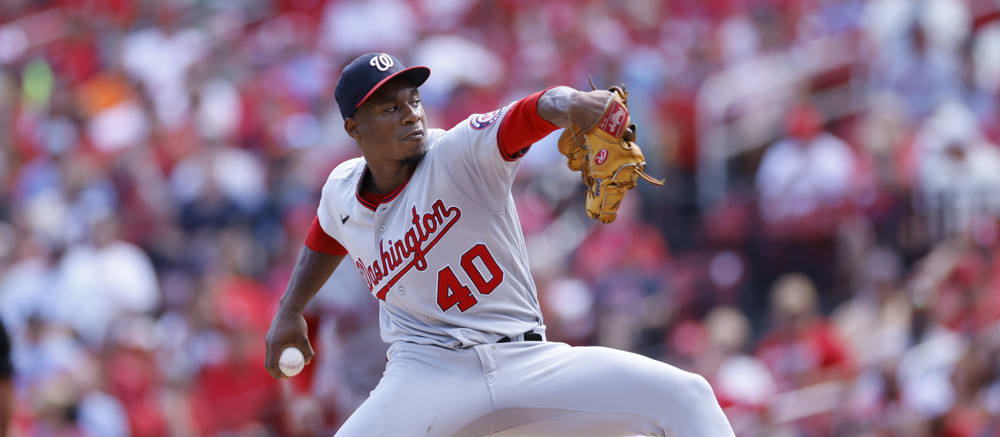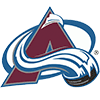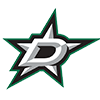I trust everyone is having a good offseason and hope that Thanksgiving was all that you wanted it to be. I've spent most of my time since the season ended focused on many of the player outlooks you will read on the site either as you begin your 2023 drafts now (you sickos!) or as you prepare for drafts in the coming weeks. I haven't joined the fun of any of the drafts going on yet, but some of the data is certainly interesting. For instance, someone who took Bryce Harper sixth overall could not have liked hearing the news that he isn't going to competitively hit until at least mid-May as he recovers from Tommy John Surgery. It's my experience that early prognostications are extremely optimistic, so I typically add at least three weeks onto the initial date as I attempt to project when that player returns. That timeline pushes Harper into mid-June for a return, yet some are considering taking him in the top 100. Hard pass!
This is not an ADP exercise as much as it is an article I've had bouncing around in my head while I work on these player outlooks. When I take a player off the list to write them up, I go through the exercise of looking at their numbers across the board, read up on news and watch some video clips if something in the numbers really stands out. Often, I'll see some things in the numbers which get me to
I trust everyone is having a good offseason and hope that Thanksgiving was all that you wanted it to be. I've spent most of my time since the season ended focused on many of the player outlooks you will read on the site either as you begin your 2023 drafts now (you sickos!) or as you prepare for drafts in the coming weeks. I haven't joined the fun of any of the drafts going on yet, but some of the data is certainly interesting. For instance, someone who took Bryce Harper sixth overall could not have liked hearing the news that he isn't going to competitively hit until at least mid-May as he recovers from Tommy John Surgery. It's my experience that early prognostications are extremely optimistic, so I typically add at least three weeks onto the initial date as I attempt to project when that player returns. That timeline pushes Harper into mid-June for a return, yet some are considering taking him in the top 100. Hard pass!
This is not an ADP exercise as much as it is an article I've had bouncing around in my head while I work on these player outlooks. When I take a player off the list to write them up, I go through the exercise of looking at their numbers across the board, read up on news and watch some video clips if something in the numbers really stands out. Often, I'll see some things in the numbers which get me to make mental comparisons to other pitchers. There were two particular pitchers whose studies really got me thinking about such comparisons and what could happen in 2023. Both of these pitchers are currently outside the top 350 overall, so these aren't high-profile arms as much as late darts who intrigue me enough to consider them in the end-game. Conveniently, we have both an NL and an AL pitcher to review, which allows me to keep single-league format players interested, as these are the types of pitchers they must draft from their player pool, while standard, 12-team leagues with seven-man benches are possibly considering these names in the 29th or 30th round. I want to take a deeper look at Washington's Josiah Gray and Baltimore's Kyle Bradish, as I have interesting comps for each of them, starting with Gray.
I liked Gray quite a bit coming into the 2022 season, but that bold prediction blew up about as badly as his ERA did with all the homers he allowed. My years of experience as a fantasy manager have reminded me to never quit on a guy no matter how poorly that player did the previous year and fall victim to recency bias. I have spent some time studying Gray and the comp which I continue to come back to is Triston McKenzie. McKenzie is a player I identified in last December's scrap heap article, and spoiler alert, Gray will be in this year's installment of that piece. To be clear, I'm not comparing the 2022 versions of both guys, but I do see some similarities in the 2021 version of McKenzie and the 2022 version of Gray. Both pitchers are atypical body types for what they do, but both also possess wicked breaking stuff. McKenzie's breaking balls generate a higher Whiff%, but look at how similarly the two pitchers are by two metrics:
PITCH | Gray 2022 | McKenzie 2021 |
Slider xBA | 0.179 | 0.221 |
Slider Whiff% | 38% | 44% |
Curve xBA | 0.185 | 0.128 |
Curve Whiff% | 32% | 44% |
Fasball xBA | 0.260 | 0.259 |
Fastball Whiff% | 17% | 19% |
Eerie, right? This is what initially led me down the research path with Gray, because I wanted to see how someone with good breaking-ball behaviors could struggle as much as he did. McKenzie's name was the first thing that came to mind. In 2021, McKenzie ran into trouble when he pitched from behind in the count because he primarily did so with fastballs, and the league punished him for it compared to how they did when he was pitching while even or ahead in the count, as I outlined in my bold prediction for him this past winter. The numbers were even worse for Gray last season:
SPLIT | PA | BA | OBP | SLG | K% |
Batter Ahead | 236 | .230 | .449 | .558 | 13% |
Even Count | 206 | .301 | .302 | .611 | 23% |
Pitcher Ahead | 207 | .184 | .203 | .309 | 37% |
You may ask yourself how a pitcher could do worse when even in the count than behind in the count. The graphic below shows the pitch mix Gray uses in each count and take note of the 0-0, 1-1, and 2-2 pie charts:
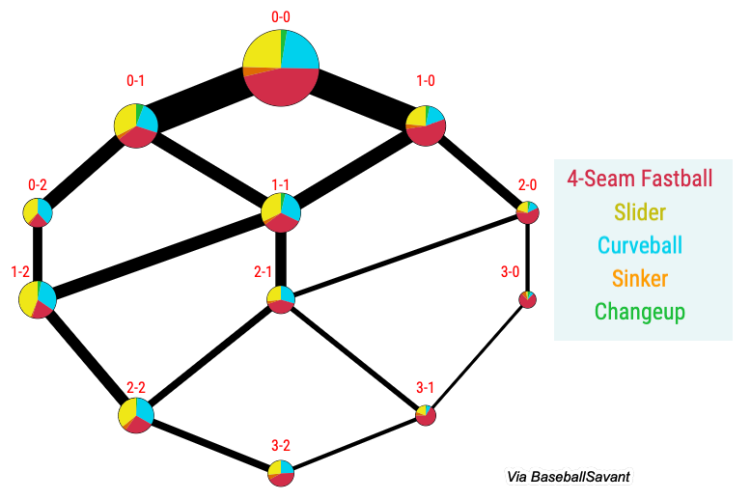
The distribution in both the 1-1 and 2-2 counts are identical, but Gray threw fastballs 50 percent of the time as a first pitch. There is a longstanding truism in baseball which tells pitchers to establish their fastball early and get hitters to expand the zone late. That may be a recipe for success for many pitchers, but Gray is not blessed with great fastball characteristics, so when the league is sitting heater on the first pitch, and getting one half the time, it's no wonder they hit .371/.381/.790 with 7 homers in the first pitch of a plate appearance. The comparison to McKenzie loses its strength when we isolate in on the fastball performances of the two pitchers, because Gray's fastball was a massive problem this past season:
Pitcher | Fastball% | HR | BA | xBA | SLG | xSLG | SW% | Whiff% | K% | wOBA | EV | SPIN |
McKenzie 2021 | 62% | 16 | 0.227 | 0.259 | 0.465 | 0.471 | 51% | 19% | 20% | 0.348 | 91 | 2256 |
Gray 2022 | 43% | 25 | 0.307 | 0.264 | 0.717 | 0.615 | 45% | 17% | 8% | 0.472 | 91 | 2210 |
Gray's fastball challenges were nearly the same against righties and lefties because he lacks an effective offspeed pitch. His overall numbers are much worse against lefties (.415 wOBA) than righties (.300 wOBA), which is where the lack of something offspeed or something that moves away from lefties is rather noticeable. Pitchers who have extreme struggles tend to attempt to hide their weakness by walking guys rather than giving into them, and Gray's 16 percent walk rate when facing lefties harkens back to Brad Keller-ish splits. By xBA and Whiff%, the two pitchers are rather similar, but Gray's fastball mistakes where he misses location are simply punished more frequently than McKenzie's were in 2021.
For me to stay on the Gray bandwagon, I need to see some news of him working on his changeup or adding some kind of offspeed pitch before the season starts. His splits are simply too extreme to consider against most lineups, as anyone who can stack lefties against him should be in for a nice day at the plate:
SPLIT | TBF | HR | K-BB% | AVG | SLG | WHIP |
vs RH | 369 | 16 | 18% | 0.221 | 0.412 | 1.81 |
vs LH | 280 | 22 | 8% | 0.265 | 0.598 | 1.07 |
The potential is there for Gray to take a much-needed step forward in 2023, but something has to change this winter for that to happen. For now, he remains a reserve-round target for me outside of NL-Only leagues, where he should be considered end-game material. There is still good in him, but Washington needs to work with him to improve his offspeed pitch as his fastball is in desperate need to a change-of-pace partner because it's simply too hittable in most areas of the strike zone:
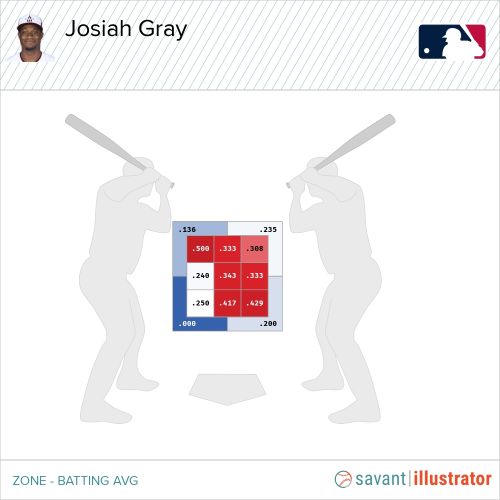
Bradish is the more attractive of the two beltway pitchers, as he had impressive strikeout rates throughout the minor leagues and showed flashes of promise in his rookie season in Baltimore around some meltdowns. This is the same pitcher who shut out the World Champion Astros over 16.2 innings with 16 strikeouts as well as the same guy who allowed five or more earned runs in five other outings last season. You might envision some extreme home/road splits with the changes to Camden Yards last season, and Bradish certainly had those, but not in the way you'd expect. He pitched to a .239 average and allowed 5 homers on the road but had a .288 average and 12 homers at home. Like Gray, Bradish had a fastball problem last season, as the league hit .318 (.296 xBA) off his fastball with 11 of his 17 homers coming off the pitch. He also had a problem using too many fastballs when behind in the count:
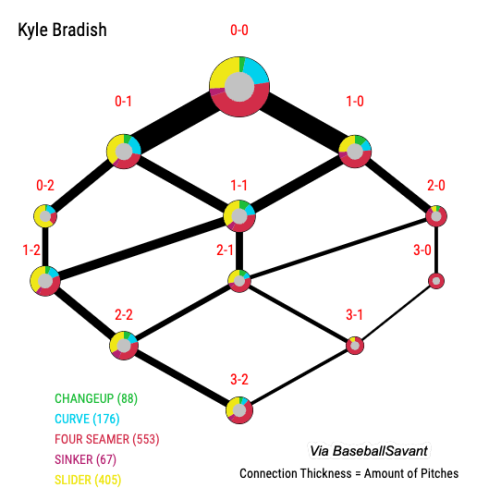
The Plinko chart shows how Bradish's journey tilted in favor of the hitter more often than not, and that was problematic for him as someone who was extremely fastball-heavy when behind in the count:
SPLIT | PA | BA | OBP | SLG | K% |
Batter Ahead | 191 | .305 | .468 | .482 | 16% |
Even Count | 172 | .291 | .310 | .406 | 19% |
Pitcher Ahead | 146 | .196 | .207 | .371 | 32% |
The league's average against his fastball was 100 points higher than against any of his other pitches. It would be easy to say he should simply avoid throwing that many fastballs, but when rookies are behind in the count, few have the command or trust in their non-fastballs to climb their way back into a better situation. I don't have any one particular pitching comp for Bradish, but I do want to point out the top five names which show up on his Pitcher Match Score (Pitchers by Speed and Movement in same season) on BaseballSavant, as they're interesting to say the least:
- Mitch White - .70
- Brad Keller - .67
- Corbin Burnes - .61
- Zac Gallen - .43
- Drew Rasmussen - .41
One differentiator in this odd grouping of pitchers are the three with well-performing fastballs and the three guys without them. Burnes and Gallen both had elite results with their fastballs, while Rasmussen had a very effective year with his heater. The other three arms had more hittable fastballs that were safely put into play too often:
| PITCHER | PITCHES | USE% | PA | HR | BA | K% | wOBA |
| Bradish | 973 | 49 | 254 | 11 | 0.318 | 16 | 0.402 |
| White | 887 | 52 | 229 | 5 | 0.300 | 11 | 0.373 |
| Keller | 1339 | 59 | 362 | 8 | 0.294 | 15 | 0.345 |
| Rasmussen | 1616 | 72 | 403 | 8 | 0.230 | 18 | 0.271 |
| Burnes | 2049 | 63 | 517 | 12 | 0.217 | 25 | 0.293 |
| Gallen | 1847 | 63 | 436 | 10 | 0.188 | 24 | 0.265 |
Bradish's breaking balls are closer to the better names in the grouping than White or Keller:
PITCHER | Pitches | USE% | PA | HR | BA | K% | wOBA |
Keller | 821 | 36 | 225 | 7 | 0.265 | 20 | 0.336 |
White | 762 | 44 | 198 | 4 | 0.258 | 25 | 0.296 |
Bradish | 850 | 43 | 214 | 5 | 0.218 | 29 | 0.269 |
Rasmussen | 623 | 28 | 181 | 5 | 0.205 | 30 | 0.266 |
Gallen | 670 | 23 | 155 | 2 | 0.169 | 37 | 0.199 |
Burnes | 903 | 28 | 205 | 6 | 0.141 | 44 | 0.194 |
His changeup falls smack in the middle of the pack for the five pitchers who throw a changeup. (Rasmussen doesn't utilize one.) That changeup helped Bradish hold lefties to a .235 average and a .303 wOBA with 4 homers, but righties did the most damage with a .280 average and a .350 wOBA and 13 home runs. Considering the right-handed bats which populate the AL East, that kind of split shouldn't be surprising. Bradish had the highest wOBA against righties among the sextet, just ahead of White and Keller at .350, and matters were worse when he was behind in the count, when the league managed a .438 wOBA against him.
Bradish has the individual pitches to make an interesting step forward this year if he can find the strike zone with more regularity earlier in the count. His StatCast profile is loaded with a lot of blue ink, but then you watch what he did on September 22 against the Astros and it's very tough not to be intrigued with his future. Watching it really does validate the Brad Keller comps, but I do believe he can move closer to the Rasmussen comp than the Keller or White comp in 2023.


